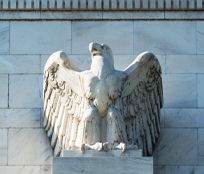In the wake of the US presidential election, the Federal Open Market Committee (FOMC) announced today a further 25-basis-point (bp) cut to the policy rate, bringing the target range for the fed funds rate to 4.50%-4.75%. The move itself was widely anticipated and only minimal changes were made to the policy statement. In the post-meeting press conference, Fed Chair Jerome Powell did not deviate much from recent assessments of the US economy, the current stance of monetary policy relative to “neutral,” and the risks to achieving both sides of the dual mandate.
As has been typical of late, Chair Powell began the press conference with prepared remarks that acknowledged recent progress made on inflation, a “solid” but not overheated labor market and the importance of incoming data in determining the future path of monetary policy. In characterizing the 75 bps of easing seen since the September FOMC meeting, the Chair again used the word “recalibration” rather than “easing” to describe what the committee believes to be a gradual move toward a more neutral policy stance. While the median dot from the most recent Summary of Economic Projections from September calls for one more 25-bp rate cut in December, the Chair was careful to indicate that this should not be viewed as a foregone conclusion. Instead, he reiterated that the Fed remains dependent on the incoming data.
When asked about how recent election results might factor into any upcoming monetary policy decisions, Powell resolutely made known that they would have no impact “in the near term” and would only be factored into Fed economic models once specific legislation was passed. While Powell’s answer was not surprising, it overlooks an indirect way that election results could impact monetary policy—through financial conditions. As has been evident over the past few days, financial conditions (generally driven by asset prices and interest rates) can respond quickly to expected changes in fiscal and regulatory policy. At a later point in the Q&A, Powell acknowledged that any changes to financial conditions thought to be “material” and “persistent” would be considered when it comes to setting policy.
With the election finally over, it remains our view that the market’s focus will again shift back to the incoming inflation and labor market data. Much like Chair Powell, Western Asset continues to believe that despite some recent stickiness, considerable progress has already been made on inflation and that progress is likely to continue in 2025. With inflation at 2.65%, as measured by the September trailing 1-year core Personal Consumption Expenditures (PCE) price index, a measured normalization of rates is still the right policy prescription, which likely won’t interfere with a gradual descent back toward the Fed’s 2.00% inflation objective. As of this writing, market-implied odds of another 25-bp cut in December are around 70%, but they will remain heavily influenced by the two additional inflation readings and one additional labor market report that the Fed will have in hand before the December FOMC meeting. While the exact meeting-to-meeting cadence of interest-rate cuts from here remains a bit uncertain, the ultimate direction of travel is clear. That should be good news for bond investors.



